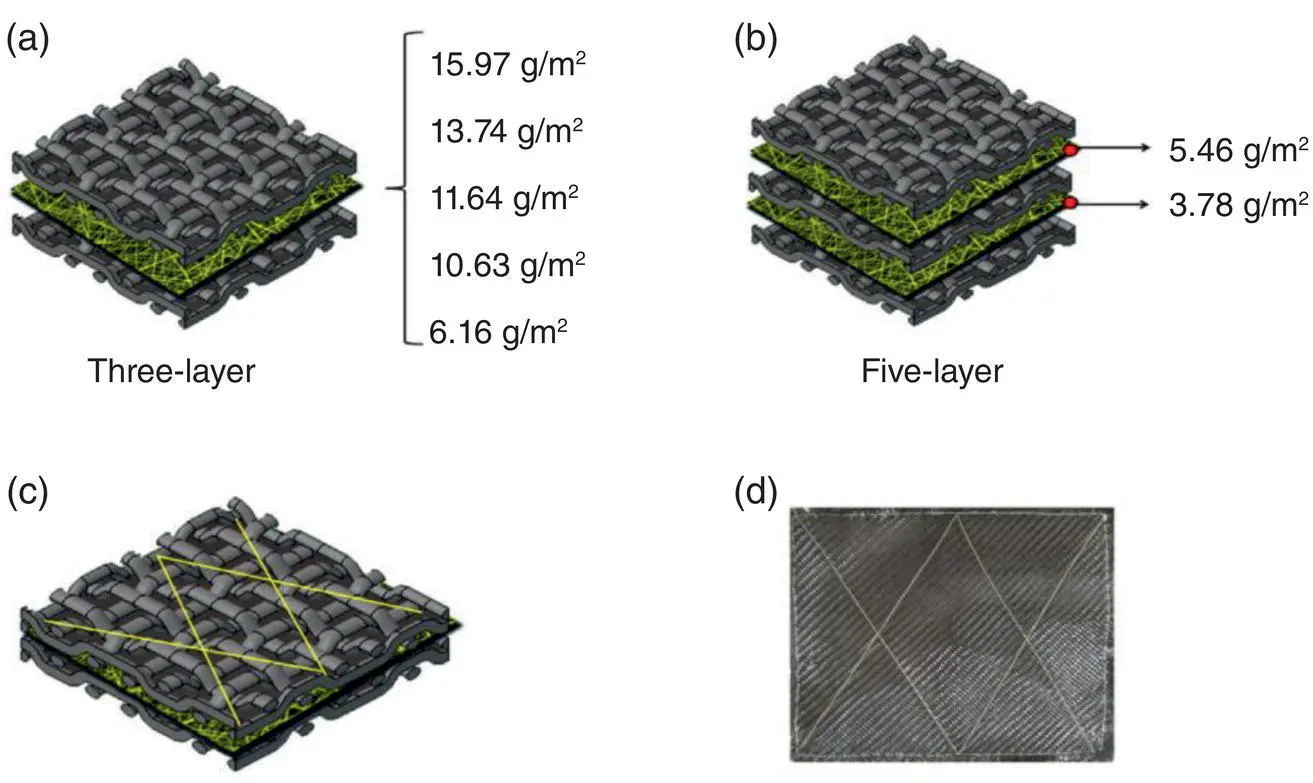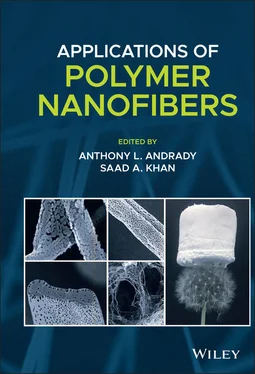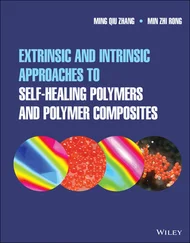Applications of Polymer Nanofibers
Здесь есть возможность читать онлайн «Applications of Polymer Nanofibers» — ознакомительный отрывок электронной книги совершенно бесплатно, а после прочтения отрывка купить полную версию. В некоторых случаях можно слушать аудио, скачать через торрент в формате fb2 и присутствует краткое содержание. Жанр: unrecognised, на английском языке. Описание произведения, (предисловие) а так же отзывы посетителей доступны на портале библиотеки ЛибКат.
- Название:Applications of Polymer Nanofibers
- Автор:
- Жанр:
- Год:неизвестен
- ISBN:нет данных
- Рейтинг книги:4 / 5. Голосов: 1
-
Избранное:Добавить в избранное
- Отзывы:
-
Ваша оценка:
- 80
- 1
- 2
- 3
- 4
- 5
Applications of Polymer Nanofibers: краткое содержание, описание и аннотация
Предлагаем к чтению аннотацию, описание, краткое содержание или предисловие (зависит от того, что написал сам автор книги «Applications of Polymer Nanofibers»). Если вы не нашли необходимую информацию о книге — напишите в комментариях, мы постараемся отыскать её.
Explore a comprehensive review of the practical experimental and technological details of polymer nanofibers with a leading new resource Applications of Polymer Nanofibers
Applications of Polymer Nanofibers
Applications of Polymer Nanofibers
Applications of Polymer Nanofibers — читать онлайн ознакомительный отрывок
Ниже представлен текст книги, разбитый по страницам. Система сохранения места последней прочитанной страницы, позволяет с удобством читать онлайн бесплатно книгу «Applications of Polymer Nanofibers», без необходимости каждый раз заново искать на чём Вы остановились. Поставьте закладку, и сможете в любой момент перейти на страницу, на которой закончили чтение.
Интервал:
Закладка:
2.5 Characteristics and Specialized Applications of Nanofiber Fabrics
Nanofiber fabric products are performed as individual materials in particular applications because of their unique properties. Researchers are taking advantage of nanofiber fabrics, developing many new application fields for them, in terms of protective clothing, filtration, wearable devices, biomedical applications, etc. (Zhu et al. 2016; Thenmozhi et al. 2017). Nanofiber fabrics, especially nonwoven type, are often set as interlayers among sandwich structure, which can guarantee the mechanical strength and filtration performance for some applications, such as filtration and protective clothing. Also in other applications, nanofiber fabrics are used as substrates for carrying functional materials. For instance, nanofiber fabrics can be used to load active materials in the field of energy storage and carry drugs in medical applications. The applications of nanofiber fabrics are introduced and discussed below in details.
2.5.1 Protective Clothing
Protective clothing is used to protect human bodies from dangerous environments, such as in high‐risk industries (e.g. hazardous chemicals, flame) as well as outdoor adventures such as in severe weather. Breathable and barrier functional clothing is one of the most attractive aspects of protective clothing (Thenmozhi et al. 2017). Synthetic fibers with high mechanical performance, combustion‐resistant organic fibers, high‐performance inorganic fibers, and so on, are all involved for this end‐use (Zhou et al. 2005). Using nanofiber fabrics as the effective interlayer is a promising design to offer enhanced barrier performance because of the size effect compared with common nonwoven fabrics. Besides, in order to satisfy the purpose of comfort, water vapor diffusion, and air permeability are commonly considered in the application of protective clothing.
Bagherzadeh et al. prepared sandwiched structure textiles by composing subtract of woven fabrics and PAN nanofiber nonwoven inner layers via electrospinning that were used for water‐repellent breathable protective clothing (Bagherzadeh et al. 2011). In this work, according to the comparison of samples with and without nanofiber nonwoven fabric, the nanofiber‐containing fabrics provided much lower air permeability and higher water vapor permeability, which were even better than those of commercial Gortex. The product possessed strong windproof properties and good water vapor permeability behavior, which was attributed to the smaller pore sizes of electrospun nanofibers in the multilayer woven fabric (Bagherzadeh et al. 2011). Additionally, Vitchuli et al. fabricated protective clothing with Nylon 6 nanofibers deposited onto woven 50/50 nylon/cotton fabric, preventing aerosol chemical, and biological threats. As a comparison, the filtration efficiency of original fabric was only 38%, indicating only a few particles were blocked by the fabric. After depositing Nylon 6 nanofibers, the performance improved significantly. The filtration efficiency raised dramatically, up to 99.5% with the increase of nanofiber areal density (Vitchuli et al. 2010). Researchers also tried to incorporate activated carbon, carbon nanotubes, and submicron enzyme particles into electrospun nanofiber fabrics to avoid hazardous materials. Gibson et al. electrospun elastomeric nanofiber fabrics for military chemical/biological protective clothing systems (Gibson et al. 2001). Nylon 6,6 was electrospun and deposited onto an activated‐carbon‐loaded PU foam. The resultant product had good water vapor diffusion and air permeability and aerosol particle penetration.
2.5.2 Filter Fabrics
Nanofiber fabrics are characterized by high surface area and high absorptivity, which have been considered as important characteristics for air and water filtrations. Particularly, with the decrease of air quality, air filter media are getting more attention, such as dust masks, engine air filtration. The usage of nanofibers is a benefit for improving filtration efficiency because of their smaller pore size and larger surface collection area (Zhang et al. 2010).
Wang et al. prepared sandwiched electrospun polyimide (PI) nanofiber fabric between carbon woven fabrics, which was used as a filter of PM 2.5 particles (Wang et al. 2016). The sandwich structure is shown schematically in Figure 2.17. The filtration efficiency of the nanofiber‐based sandwich structure reached 99.99% for PM 2.5. Even after thermal treatment at 260 °C, it could still keep high filtration efficiency and maintained good mechanical properties.
Based on good air filtration properties, Li and coworker designed a gauze mask product to prevent inhaling PM 2.5 particles by using an electrospun polysulfone nanofiber fabric (Li and Gong 2015). The result indicated that the prepared nanofiber mask demonstrated a high rejected effect larger than 90% and acceptable air permeability which was probably due to the nanoscaled fiber size. Typically, the rejected effect and air permeability property could not be satisfied simultaneously. For instance, in some cases, in order to meet the requirement of rejected effect, the fabric in the mask would be thicker, which would affect the air permeability.
Moreover, researchers have blended additives in nanofiber fabrics to achieve specific effect in the process of filtrating. For example, Park and coworker added benzyl triethylammonium chloride as an antimicrobial agent into electrospun PVA nanofibers and then deposited them onto a commercial glassfiber fabric, for use as antimicrobial water filtration (Park and Kim 2017). The antimicrobial water filtration test demonstrates that the obtained fabric could improve the removal of different types of bacteria. Apart from electrospinning, the melt‐blown method could also be used to produce nanofiber fabrics for air filtration, which was much faster, easier, and cheaper. Hassan et al. investigated the die geometry and operating conditions of the melt‐blown process to prepare PP nanofiber nonwoven fabrics for use in air filtration field (Hassan et al. 2013). By using the melt blowing process, the production rate of nanofiber nonwoven fabrics with an average fiber diameter of around 330 nm was able to achieve 2.23 kg/h/m of die width. The experiments also showed that the fabric basis weight and the fiber size could be designed in this approach to achieve higher air permeability and higher filtration quality.

Figure 2.17 The structure of (a) three‐layered and (b) five‐layered PI nanofiber/carbon woven fabric composite filter, (c, d) diagram and digital photos of the composite filters.
Source: (a–d) Wang et al. (2016); (d) Reproduced with permission from Wang et al. (2016). Copyright 2016, Elsevier.
2.5.3 Wearable Devices
Wearable devices are an attractive part of smart textiles. Wearable devices are known as electronic parts incorporated into clothing or accessories, which can collect and analyze information and data. Normally, wearable devices are lightweight and bendable. Benefited from the excellent flexibility and high surface area, nanofiber‐based materials are an excellent candidate for applications of wearable devices. Park et al. presented a sandwich structure of highly transparent electrospun keratin/PVA nanofiber embedded in textiles, which are used in polymer light‐emitting diodes (Park et al. 2016). Keratin was extracted from human hair and mixed with PVA, then electrospun into keratin/PVA nanofiber fabrics. After the “dip and dry” process, the obtained nanofiber fabrics were transparent. Then the fibers were sandwiched with electrodes and assistant layers, shown in Figure 2.18. After assembly, the optical and electrical analysis demonstrated that the devices were bendable and gave out lights of white, yellow, and red color. Gheibi et al. produced a one‐step nanogenerator by using piezoelectric electrospun PVDF nanofibers incorporating the electrodes within the structure of the device for use as self‐powering wearable electronics (Gheibi et al. 2014). The effect of deformation on the output voltage of the device was measured on the Keithley instrument by tapping, and a maximum peak of voltage output reached 1 V.
Читать дальшеИнтервал:
Закладка:
Похожие книги на «Applications of Polymer Nanofibers»
Представляем Вашему вниманию похожие книги на «Applications of Polymer Nanofibers» списком для выбора. Мы отобрали схожую по названию и смыслу литературу в надежде предоставить читателям больше вариантов отыскать новые, интересные, ещё непрочитанные произведения.
Обсуждение, отзывы о книге «Applications of Polymer Nanofibers» и просто собственные мнения читателей. Оставьте ваши комментарии, напишите, что Вы думаете о произведении, его смысле или главных героях. Укажите что конкретно понравилось, а что нет, и почему Вы так считаете.












